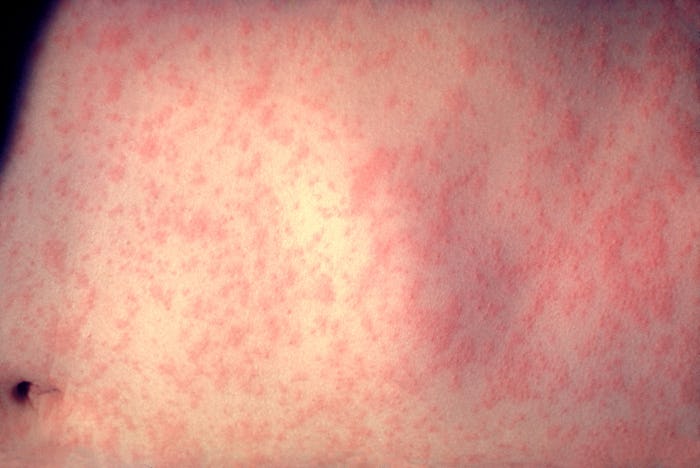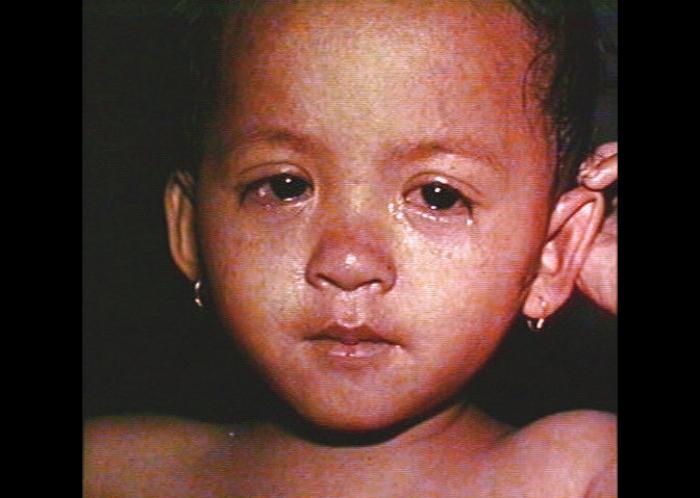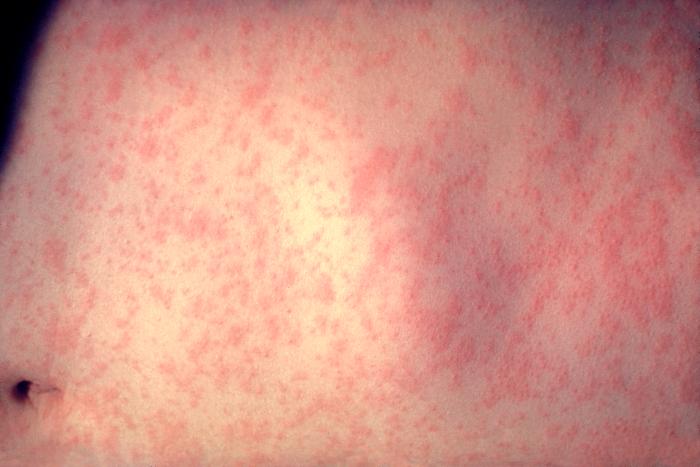Life

Here's What A Measles Rash *Actually* Looks Like
If you are anything like me, finding a rash on your toddler is stressful as hell. Even though most of the time a rash ends up being no big deal or something that can be easily treated, my mind always goes to the worst case scenario — measles. And since a large number of cases have been confirmed throughout the United States, it's important for parents to know a measles rash looks like so they can get their child treatment right away.
Fortunately for worried parents everywhere, the rash from measles is quite distinctive and comes with other telltale symptoms that will help make it clear that your child is suffering from the measles. According to the Centers for Disease Control and Prevention (CDC), as of August 11, 2018, 124 confirmed cases of measles had been reported from 22 states. While they aren’t officially calling this an outbreak, officials are advising parents to vaccinate their kids and to be on the lookout for the signs and symptoms of measles, especially if their kids are too young or are unable to be vaccinated.
According to the CDC, the first signs of the virus actually occur long before a rash develops and can actually look like a cold or the flu — like a runny nose, red, watery eyes, a cough, and a high fever of 104° Fahrenheit or higher. The same site reports that two or three days later, a person with measles may develop a white spots in their mouth called Koplik spots.

Mayo Clinic reports that the measles rash usually appears three to five days after the other symptoms have occurred. The same site notes that the rash starts on your child's face, and then spreads down their neck, chest, legs, and feet. The rash typically begins as small, red dots, which can be raised, flat, or a little bit of both, but then may grow and join together to form large red patches as it spreads.
According to BabyCenter, the measles rash will typically only last a few days before fading away and leaving behind patches of dry skin. The effects can be long-lasting, though, and a reported 30 percent of children will develop complications from the illness, including diarrhea, hepatitis, heart problems, encephalitis, and pneumonia, which is the leading cause of death for children with measles.

As Healthline reports, while some parents might mistake other rashes for measles, like roseola, they don't generally look the same. Measles rash starts on the face and spreads to other areas of the body, while roseola starts on the trunk and spreads to the arms and neck. As Dr. Sarah Jarvis tells Express, the more common chicken pox rash causes a itchy, fluid-filled rash to form as opposed to the fine red dots caused by measles, which may or may not be itchy.
The measles is super contagious, according to BabyCenter, and if your child is unvaccinated and comes into contact with someone who has measles their chances of contracting the virus is about 90 percent. Unlike chicken pox, however, measles is contagious before a rash even develops, according to BabyCenter, and is actually transmitted by droplets in the air from coughing or sneezing and not by touching the rash.

As the CDC reports, the majority of people who've contracted measles this year were unvaccinated. In other words, the best way to prevent your kids from contracting the virus is to vaccinate them with the measles, mumps, and rubella (MMR) vaccine, which is given in two doses between 12 and 15 months and 4 and 6 years of age.
As always, if your child has a rash or high fever it's always a good idea to call their doctor or take them in to get checked out. It's especially important to contact a health care provider if your child shows other signs of a potentially serious illness like the measles and they haven't been vaccinated. It's better to be safe than sorry, and unfortunately, measles doesn't appear to be going away anytime soon.